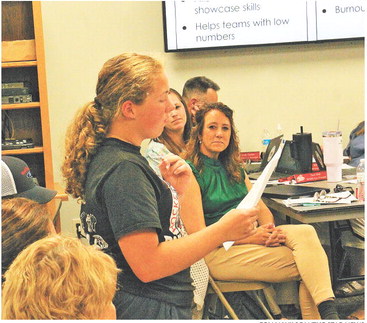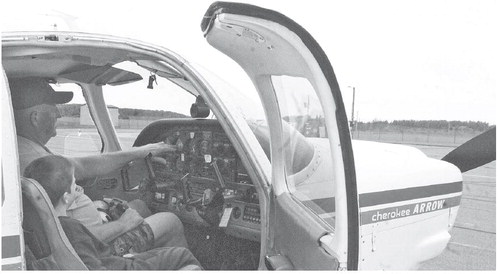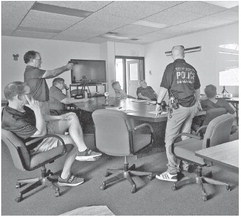Rib Lake’s Railroad History:
Rib Lake, Wisconsin, once had three different railroad systems.The first was theWisconsin Central Railroad (WC), later bought by the Soo Line Railroad. It hauled passengers and freight. The Wisconsin Central was a “common carrier” obligated by law to haul freight and/or passengers for anyone willing to pay its fees. The second type of Rib Lake railroad was a logging railroad. A logging railroad was owned by a lumber company and only hauled its own logs to its own sawmill. Both the WC and Rib Lake Lumber Co. (RLLC) logging railroad were “standard gauge”, i.e., their tracks were 4 feet 8 1⁄2 inches apart.
The third type of railroad was “narrow gauge”; its small rails were only three feet apart and called a “tramway”. It was owned by the RLLC to move recently cut “green” lumber from the RLLC sawmill. Horses pulled tram cars of lumber from the sawmill, over a bridge above McComb Avenue, to the 50-acre dry yard in the center of the Village where the green lumber was piled to dry by air.
On June 5, 1871, the WC Railroad began construction at the City of Menasha, near Green Bay, Wisconsin. In 1872, the work of clearing, leveling, grubbing, and grading the right- of-way was completed through what would become, on March 3, 1875, Taylor County.
On April 15, 1873, the WC started laying track at Colby northward and arrived at Worcester, Mile Post 101, on January 6, 1874. Worcester, now in Price County, remained the northern terminus of the Wisconsin Central until June 1876 due to financial problems. In June of 1873, the first regular train passed through the City of Medford, Wisconsin.
John J. Kennedy, the founder of Rib Lake, first scouted the land around Rib Lake in 1881. On behalf of his employer, the Curtis & Carpenter Lumber Company, he supervised building a sawmill at Rib Lake, which sawed its first board on December 21, 1881.
A major problem confronting Kennedy’s sawmill was a lack of a railroad connection to the outside world. For the first two years, all of the lumber sawed at Rib Lake had to be moved by wagon or sleigh to Chelsea, where it would be railroaded away on the WC.
In 1883, the WC completed a five-mile railroad spur between Chelsea and Rib Lake. For two years, construction had been stymied by hills. A route suitable for railroad was finally made by filling in the north portion of Wellington Lake. This fill is now covered by trees.
In 1892, J.J. Kennedy bought the Rib Lake mill and operated it as the Kennedy Lumber Company. He learned that several mills in Wisconsin found railroads to be a cost-effective way to move heavy green logs. About 1897, Kennedy built a 1 1⁄2 -mile-long logging railroad into the forested hills northwest of Rib Lake.
Kennedy’s only locomotive was named the “Nancy Hanks,” built for passenger service. Kennedy’s railroad was a failure and quickly abandoned. It had no track directly to the sawmill.
Instead, logs were dumped into Rib Lake near Broadway Street and floated to the mill. Most logs do not float well.
On September 1, 1900, W.A. Osburn bought out Kennedy and on May 5, 1902, adopted the name Rib Lake Lumber Company (RLLC). The WC in 1902 extended its track past the sawmill and along the north shore of Rib Lake and to the northeast into Price County where it joined the Marinette, Tomahawk, and Western Railroad (MT& W) near Spirit Falls. The WC seriously considered buying the MT& W but concluded that a freight and passenger train between Rib Lake and Tomahawk would not be profitable.
In 1906, the RLLC built a seven-mile spur past Wood Lake and in 1913 extended it to Camp 10 near the Taylor-Price County line. A branch line was built to the Wood Lake lakeshore. There its McGiffert loader pulled saw logs from Wood Lake and loaded them on flatcars for shipment to the Rib Lake mill.
1906 also saw the RLLC rent railroad track from the WC and build a spur from near Goodrich, WI into Lincoln County to serve RLLC Camp 1. A daily RLLC locomotive hauled logs from Camp 1 through the Village of Athens, Abbotsford, Dorchester, Stetsonville, Medford, and Chelsea to Rib Lake using the WC mainline. The Minneapolis, St. Paul, and Sault Ste. Marie Railway Company (aka Soo Line) in April 1909 bought the WC.
In 1923, the RLLC constructed a long major new logging line. It extended its mainline southward through the forests of western Lincoln County from which only the pine had been cut. This was one of the last, large near-virgin forests in Wisconsin and was owned by the United States Leather Co. which also owned the RLLC. This line was built over 10 miles to the Marathon County line where Camp 19 was built. The RLLC plan was to clear-cut first areas farthest from the Rib Lake mill. After that area was logged, the tracks were shortened to Camp 18 followed by Camps 20 through 28, each one closer to the Rib Lake mill.
The 1920s marked the golden era of the RLLC using jobber camps as well as logging camps owned and operated by the RLLC. Jobbers were individuals who contracted to cut RLLC lands and pile the saw logs along RLLC railroad tracks. The jobber built his own camp, hired and supervised his own men, and was paid by the RLLC based upon the amount of saw logs piled along RLLC railroad tracks. Peterson, Natzke, Krueger, Kleinschmidt, Freiboth, Lamberty, Bauman, and Luedtke were the surnames of some of these jobbers. Their camp sites are listed on an adjacent map, “Rib Lake Lumber Co. Railroad Operations”. It is a composite map, not all railroad tracks shown existed at the same time.
In the 1920s through the 1940s, the RLLC owned three locomotives and hired its own employees, firemen, brakemen, and conductors. It repaired much of its own rolling stock in a machine shop built big enough that a locomotive could enter the shop via a spur crossing McComb Avenue. As of February 2, 2023, this machine shop building still stands at 670 McComb Avenue, the plant of Wisco Materials.
As a cost-saving measure, the RLLC often purchased used equipment. One of its Shay locomotives had been bought new by the Westboro Lumber Co. for its railroad about 1902; when that company closed, the Shay was sold to the Medford Lumber Co., whose railroad ran almost to Perkinstown. When that company closed in 1923, the Shay was sold for the third and final time to the RLLC.
In 1936, the United States Leather Co. sold the RLLC to Aytch P. (A.P.) Woodson, John “Jack” Mylrea, Frank Handyside, and R.S. Brownell. The January 30, 1936 edition of the Star News ran this headline: “State’s Largest Sawmill Changes Hands This Week”.
The 1936 purchase of the RLLC included: 1) About 2,000 acres of timber 2) 40,000 acres of cutover land 3) Sawmill of 30,000,000 board feet yearly capacity 4) Planing mill and drysheds 5) Dry kiln 6) 25 miles of logging railroad 7) 80[railroad] flatcars 8) 3locomotives[steam engines] 9) 30million[board feet]of lumber in piles 10) $100,000.00 cash and accounts receivable 11) Office, barns, and horses 12) 53 houses in Rib Lake [“company houses,” rented to employees] 13) 2 logging camps in operation 14) 1,000 million [sic] board feet of standing timber By 1940, the new RLLC owners could see the writing on the wall: its sawmill was running out of timber. Under the aggressive leadership of Jack Myrlea, the RLLC bought timber from near Rice Lake, Wisconsin; Marensico, Michigan; and Hovland, Minnesota. The last source involved the logs being piled on the shores of Lake Superior; rafted to Ashland, Wisconsin; and moved by the Soo Line to the Rib Lake mill. John Mylrea’s notes contain his handwritten statement that the RLLC netted $10,000 profit per raft load of logs.
On February 25, 1948, the RLLC and Rib Lake Commercial Club invited everyone to ride its logging railroad to Camp 28 and witness the ceremonial felling of its last pine tree. Photographs of this nostalgic event can be viewed at www.riblakehistory.com On May 21, 1948, Chester Curran operated Engine 101 of the RLLC as it pulled its final load of saw logs from Camp 28 to its Rib Lake mill. It was the last time a logging railroad hauling sawlogs operated in Wisconsin.
Robert P. “Bob” Rusch is the Manager and Founder, Rib Lake Historical Society.




